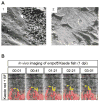Osteoblast migration in vertebrate bone
- PMID: 28631442
- PMCID: PMC6218945
- DOI: 10.1111/brv.12345
Osteoblast migration in vertebrate bone
Abstract
Bone formation, for example during bone remodelling or fracture repair, requires mature osteoblasts to deposit bone with remarkable spatial precision. As osteoblast precursors derive either from circulation or resident stem cell pools, they and their progeny are required to migrate within the three-dimensional bone space and to navigate to their destination, i.e. to the site of bone formation. An understanding of this process is emerging based on in vitro and in vivo studies of several vertebrate species. Receptors on the osteoblast surface mediate cell adhesion and polarization, which induces osteoblast migration. Osteoblast migration is then facilitated along gradients of chemoattractants. The latter are secreted or released proteolytically by several cell types interacting with osteoblasts, including osteoclasts and vascular endothelial cells. The positions of these cellular sources of chemoattractants in relation to the position of the osteoblasts provide the migrating osteoblasts with tracks to their destination, and osteoblasts possess the means to follow a track marked by multiple chemoattractant gradients. In addition to chemotactic cues, osteoblasts sense other classes of signals and utilize them as landmarks for navigation. The composition of the osseous surface guides adhesion and hence migration efficiency and can also provide steering through haptotaxis. Further, it is likely that signals received from surface interactions modulate chemotaxis. Besides the nature of the surface, mechanical signals such as fluid flow may also serve as navigation signals for osteoblasts. Alterations in osteoblast migration and navigation might play a role in metabolic bone diseases such as osteoporosis.
Keywords: bone; cell migration; chemotaxis; fluid flow; mineralized surfaces; osteoblasts.
© 2017 Cambridge Philosophical Society.
Figures




References
-
- Abdelgawad ME, Soe K, Andersen TL, Merrild DM, Christiansen P, Kjaersgaard-Andersen P, Delaisse JM. Does collagen trigger the recruitment of osteoblasts into vacated bone resorption lacunae during bone remodeling? Bone. 2014;67:181–188. - PubMed
-
- Baldini G, Ponti C, Bortul R, Narducci P, Grill V, Martelli AM. Sparc localizes to the blebs of hobit cells and human primary osteoblasts. Journal of Cellular Biochemistry. 2008;104:2310–2323. - PubMed
-
- Balogh ZJ, Reumann MK, Gruen RL, Mayer-Kuckuk P, Schuetz MA, Harris IA, Gabbe BJ, Bhandari M. Advances and future directions for management of trauma patients with musculoskeletal injuries. Lancet. 2012;380:1109–1119. - PubMed
-
- Basso FG, Silveira Turrioni AP, Hebling J, de Souza Costa CA. Zoledronic acid inhibits human osteoblast activities. Gerontology. 2013;59:534–541. - PubMed
-
- Baum B, Settleman J, Quinlan MP. Transitions between epithelial and mesenchymal states in development and disease. Seminars in Cell & Developmental Biology. 2008;19:294–308. - PubMed
Publication types
MeSH terms
Grants and funding
LinkOut - more resources
Full Text Sources
Other Literature Sources
Research Materials

